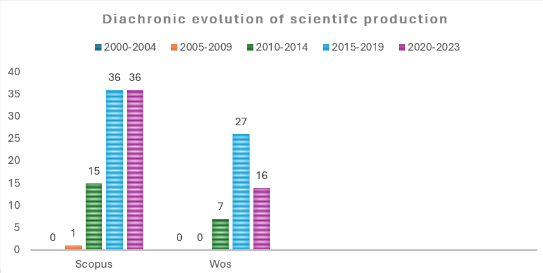Exploring the effect of demographic characteristics and personality traits on attitude toward AI-assisted second language learning among Chinese college students: A multiple regression analysis
Abstract
Previous research underscores the pivotal role of AI in advancing second language (L2) learning, yet gaps persist in understanding how individual differences shape L2 learners’ perceptions of AI resources. Addressing this gap, this study explored the impact of demographic characteristics (age and gender) and personality traits (extroversion, agreeableness, conscientiousness, neuroticism, and openness) on attitude toward AI-assisted L2 learning. This attitude encompasses the opinions, feelings, and beliefs individuals hold about using AI as a tool to facilitate L2 learning. Data were collected from 493 L2 learners enrolled in Chinese colleges through an online questionnaire using two validated scales. Through SPSS 26, descriptive statistics indicated a moderately high positive attitude among students. Multiple regression analyses revealed that older students and females exhibited more favorable attitude compared to their younger and male counterparts, respectively. Additionally, personality traits—excluding agreeableness—significantly influenced attitude. Besides, extroversion and neuroticism negatively predicted attitude, whereas conscientiousness and openness had positive predictive effects. Moreover, this study discusses theoretical implications and offers educational insights while suggesting avenues for future research.
References
[1]Chen X, Xie H, Hwang GJ. A multi-perspective study on Artificial Intelligence in Education: grants, conferences, journals, software tools, institutions, and researchers. Computers and Education: Artificial Intelligence. 2020; 1: 100005. doi: 10.1016/j.caeai.2020.100005
[2]Bicknell K, Brust C, Settles B. How Duolingo’s AI Learns what you Need to Learn: The language-learning app tries to emulate a great human tutor. IEEE Spectrum. 2023; 60(3): 28–33. doi: 10.1109/mspec.2023.10061631
[3]Wang Y, Xue L. Using AI-driven chatbots to foster Chinese EFL students’ academic engagement: An intervention study. Computers in Human Behavior. 2024; 159: 108353. doi: 10.1016/j.chb.2024.108353
[4]Yang L, Zhao S. AI-induced emotions in L2 education: Exploring EFL students’ perceived emotions and regulation strategies. Computers in Human Behavior. 2024; 159: 108337. doi: 10.1016/j.chb.2024.108337
[5]Marquis P, Papini O, Prade H, et al. A Guided Tour of Artificial Intelligence Research. Springer International Publishing; 2020. doi: 10.1007/978-3-030-06170-8
[6]Son JB, Ružić NK, Philpott A. Artificial intelligence technologies and applications for language learning and teaching. Journal of China Computer-Assisted Language Learning. 2023. doi: 10.1515/jccall-2023-0015
[7]Crompton H, Burke D. Artificial intelligence in higher education: the state of the field. International Journal of Educational Technology in Higher Education. 2023; 20(1). doi: 10.1186/s41239-023-00392-8
[8]Gardner J, O’Leary M, Yuan L. Artificial intelligence in educational assessment: ‘Breakthrough? Or buncombe and ballyhoo?’ Journal of Computer Assisted Learning. 2021; 37(5): 1207-1216. doi: 10.1111/jcal.12577
[9]Castañeda L, Selwyn N. More than tools? Making sense of the ongoing digitizations of higher education. International Journal of Educational Technology in Higher Education. 2018; 15(1). doi: 10.1186/s41239-018-0109-y
[10]Wu H, Liu W, Zeng Y. Validating the AI-assisted second language (L2) learning attitude scale for Chinese college students and its correlation with L2 proficiency. Acta Psychologica. 2024; 248: 104376. doi: 10.1016/j.actpsy.2024.104376
[11]Spencer H. First principles, 2nd ed. Williams and Norgate: London; 1867.
[12]Ajzen I, Fishbein M. Attitude-behavior relations: A theoretical analysis and review of empirical research. Psychological Bulletin. 1977; 84(5): 888–918. doi: 10.1037/0033-2909.84.5.888
[13]Reid N, Amanat Ali A. Making Sense of Learning. Springer International Publishing; 2020. doi: 10.1007/978-3-030-53677-0
[14]Jafari J, Xiao H. Encyclopedia of Tourism. Springer Nature; 2016. doi: 10.1007/978-3-319-01384-8
[15]Eagly AH, Chaiken S. The psychology of attitudes. Harcourt Brace Jovanovich College Publishers: Orlando, FL, US; 1993. pp. xxii,794-xxii,794.
[16]Ries F. The ECPH Encyclopedia of Psychology. Springer Nature Singapore; 2024. doi: 10.1007/978-981-99-6000-2
[17]Davis FD. Perceived Usefulness, Perceived Ease of Use, and User Acceptance of Information Technology. MIS Quarterly. 1989; 13(3): 319. doi: 10.2307/249008
[18]Fishbein M, Ajzen I. Belief, attitude, intention and behaviour: An introduction to theory and research. Addison-Wesley: Reading, MA; 1975. p. 27.
[19]Venkatesh V, Thong J, Xu X. Unified Theory of Acceptance and Use of Technology: A Synthesis and the Road Ahead. Journal of the Association for Information Systems. 2016; 17(5): 328–376. doi: 10.17705/1jais.00428
[20]Zheng Y, Wang Y, Liu KSX, et al. Examining the moderating effect of motivation on technology acceptance of generative AI for English as a foreign language learning. Education and Information Technologies. 2024. doi: 10.1007/s10639-024-12763-3
[21]An X, Chai CS, Li Y, et al. Modeling students’ perceptions of artificial intelligence assisted language learning. Computer Assisted Language Learning. 2023; 1–22. doi: 10.1080/09588221.2023.2246519
[22]Liu G, Ma C. Measuring EFL learners’ use of ChatGPT in informal digital learning of English based on the technology acceptance model. Innovation in Language Learning and Teaching. 2023; 18(2): 125–138. doi: 10.1080/17501229.2023.2240316
[23]Schepman A, Rodway P. The General Attitudes towards Artificial Intelligence Scale (GAAIS): Confirmatory Validation and Associations with Personality, Corporate Distrust, and General Trust. International Journal of Human—Computer Interaction. 2022; 39(13): 2724–2741. doi: 10.1080/10447318.2022.2085400
[24]Wu H, Wang Y, Wang Y. “To use or not to use?”: A mixed-methods study on the determinants of EFL college learners’ behavioral intention to use AI in the distributed learning context. The International Review of Research in Open and Distributed Learning. 2024.
[25]Devaraj S, Easley RF, Crant JM. Research Note—How Does Personality Matter? Relating the Five-Factor Model to Technology Acceptance and Use. Information Systems Research. 2008; 19(1): 93-105. doi: 10.1287/isre.1070.0153
[26]Costa PT, McCrae RR. The Five-Factor Model of Personality and Its Relevance to Personality Disorders. Journal of Personality Disorders. 1992; 6(4): 343–359. doi: 10.1521/pedi.1992.6.4.343
[27]Costa PT, McCrae RR. Domains and facets: Hierarchical personality assessment using the Revised NEO Personality Inventory. Journal of Personality Assessment. 1995; 64: 21–50. doi:10.1207/s15327752jpa6401_2
[28]Power RA, Pluess M. Heritability estimates of the Big Five personality traits based on common genetic variants. Translational Psychiatry. 2015; 5(7): e604-e604. doi: 10.1038/tp.2015.96
[29]Wang X, Wang S. Exploring Chinese EFL learners’ engagement with large language models: A self-determination theory perspective. Learning and Motivation. 2024; 87: 102014. doi: 10.1016/j.lmot.2024.102014
[30]Wang X, Reynolds BL. Beyond the Books: Exploring Factors Shaping Chinese English Learners’ Engagement with Large Language Models for Vocabulary Learning. Education Sciences. 2024; 14(5): 496. doi: 10.3390/educsci14050496
[31]Wu H, Wang Y, Wang Y. How burnout, resilience, and engagement interplay among EFL learners? A mixed-methods investigation in the Chinese senior high school context. Porta Linguarum Revista Interuniversitaria de Didáctica de las Lenguas Extranjeras. 2024; (IX): 193–213. doi: 10.30827/portalin.viix.29878
[32]Wu H, Zeng Y, Fan Z. Unveiling Chinese senior high school EFL students’ burnout and engagement: Profiles and antecedents. Acta Psychologica. 2024; 243: 104153. doi: 10.1016/j.actpsy.2024.104153
[33]Cooper C. Individual differences, 2nd ed. Arnold: London, England; 2002; pp. x,357-x,357.
[34]Dörnyei Z. The psychology of the language learner: Individual differences in second language acquisition. Routledge; 2005.
[35]Ghorbani M, Semiyari SR. The Impact of the Big Five Personality Traits and Motivational Self-System on Iranian EFL Learners’ Intended Effort: An Investigation into McAdams’ Model of Personality. RELC Journal. 2020; 53(1): 24–39. doi: 10.1177/0033688220933011
[36]Cao C, Meng Q. Exploring personality traits as predictors of English achievement and global competence among Chinese university students: English learning motivation as the moderator. Learning and Individual Differences. 2020; 77: 101814. doi: 10.1016/j.lindif.2019.101814
[37]Liyanage I, Bartlett B. Personality types and languages learning strategies: Chameleons changing colours. System. 2013; 41(3): 598–608. doi: 10.1016/j.system.2013.07.011
[38]Zohoorian Z. Zeraatpishe M. Willingness to Communicate, Big Five Personality Traits, And Empathy: How Are They Related? Canadian Journal of Educational and Social Studies. 2022; 2(5). doi: 10.53103/cjess.v2i5.69
[39]Chen X, He J, Swanson E, et al. Big Five Personality Traits and Second Language Learning: a Meta-analysis of 40 Years’ Research. Educational Psychology Review. 2021; 34(2): 851–887. doi: 10.1007/s10648-021-09641-6
[40]Wang MC, Dai XY, Yao SQ. Development of the Chinese Big Five Personality Inventory (CBF-Pl) Ill: Psychometric properties of CBF-Pl brief version. Chinese Journal of Clinical Psychology. 2011; 19, 454–457.
[41]Khajavy GH. L2 motivation and personality as predictors of the second language proficiency: Role of the big five traits and L2 motivational self system. Canadian Social Science. 2011; 7: 148–155, doi: 10.3968/j.css.1923669720110706.030.
[42]Goldberg LR. The development of markers for the Big-Five factor structure. Psychological Assessment. 1992; 4(1): 26–42. doi: 10.1037/1040-3590.4.1.26
[43]Kaya F, Aydin F, Schepman A, et al. The Roles of Personality Traits, AI Anxiety, and Demographic Factors in Attitudes toward Artificial Intelligence. International Journal of Human—Computer Interaction. 2022; 40(2): 497–514. doi: 10.1080/10447318.2022.2151730
[44]Gosling SD, Rentfrow PJ, Swann Jr WB. A very brief measure of the Big-Five personality domains. Journal of Research in Personality. 2003; 37: 504–528. doi:10.1016/S0092-6566(03)00046-1.
[45]Eisinga R, Grotenhuis M, Pelzer B. The reliability of a two-item scale: Pearson, Cronbach, or Spearman-Brown? International Journal of Public Health. 2012; 58(4): 637–642. doi: 10.1007/s00038-012-0416-3
[46]Hu L, Bentler PM. Cutoff criteria for fit indexes in covariance structure analysis: Conventional criteria versus new alternatives. Structural Equation Modeling: A Multidisciplinary Journal. 1999; 6(1): 1–55. doi: 10.1080/10705519909540118
[47]Field A. Discovering statistics using IBM SPSS statistics: And sex and drugs and rock’n’roll, 3rd ed. CA: Sage: Thousand Oaks; 2009.
[48]Yu C, Yao W. Robust linear regression: A review and comparison. Communications in Statistics—Simulation and Computation. 2016; 46(8): 6261–6282. doi: 10.1080/03610918.2016.1202271
[49]Podsakoff PM, MacKenzie SB, Lee JY, et al. Common method biases in behavioral research: A critical review of the literature and recommended remedies. Journal of Applied Psychology. 2003; 88(5): 879–903. doi: 10.1037/0021-9010.88.5.879
[50]Fuller CM, Simmering MJ, Atinc G, et al. Common methods variance detection in business research. Journal of Business Research. 2016; 69(8): 3192–3198. doi: 10.1016/j.jbusres.2015.12.008
[51]Stein JP, Messingschlager T, Gnambs T, et al. Attitudes towards AI: measurement and associations with personality. Scientific Reports. 2024; 14(1). doi: 10.1038/s41598-024-53335-2
[52]Xu Z, Parizi RM, Loyola-González O, et al. Cyber Security Intelligence and Analytics. Springer International Publishing; 2021. doi: 10.1007/978-3-030-69999-4
[53]Csizér K, Albert Á. Gender-Related Differences in the Effects of Motivation, Self-Efficacy, and Emotions on Autonomous Use of Technology in Second Language Learning. The Asia-Pacific Education Researcher. 2024; 33(4): 819–828. doi: 10.1007/s40299-023-00808-z
[54]Dong TH, Chen S, Tseng WT. The relationship between neuroticism and L2 anxiety: A meta-analysis. System. 2024; 123: 103293. doi: 10.1016/j.system.2024.103293
[55]Abouzeid E, Fouad S, Wasfy N, et al. Influence of Personality Traits and Learning Styles on Undergraduate Medical Students’ Academic Achievement. Advances in Medical Education and Practice. 2021; 12: 769–777. doi: 10.2147/amep.s314644
[56]Barańczuk U. The Five-Factor Model of Personality and Generalized Self Efficacy. Journal of Individual Differences. 2021; 42(4): 183–193. doi: 10.1027/1614-0001/a000345
Copyright (c) 2024 Wentao Liu, Hanwei Wu

This work is licensed under a Creative Commons Attribution 4.0 International License.









